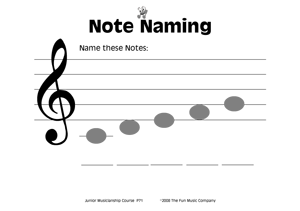Want some elementary music worksheets to help young children get a grasp of Music Theory?
Imagine for a minute your youngest student – We are talking under the age of 7, little kids. Some teachers have students as young as 4, some even younger, it doesn’t matter!
Whatever age your young children are – just focus on them and see if I can magically describe them for you:
“..… They are fidgety, they are hard to keep focused, they really struggle reading music and never practice! They do alright when it comes to the practical parts of the lesson, they seem to concentrate alright, but when it comes to theory you are really stuck. “
Am I right?
Well hopefully on this page I’ll be able to share a few ideas to help you in this area, that you can take and use in your next lesson when you’ve got one of those struggling children, or a kindergarten or young childrens music class that you need to inspire about music theory.
Just imagine – you can inpsire and motivate children to make music lessons and practice a happy and joyous time – where they will come in and enjoy every moment they spend with you!
It doesn’t matter if you are a Private Music Teacher, Classroom Music Teacher, General Elementary School Teacher, Kindergarten Teacher, or even a Parent helping children learn music the strategies on this page can help you!
Please, read this article right through to the end… Then we’ll have some free elementary music worksheets for you to assist in making lessons with your youngest students worthwhile and fun!

Dear Friend and Colleague,
Welcome to the page where I going to give you some teaching strategies to help teach young children all about music theory.
At the end of this page there will be a product you can buy – if you want. The price is $50, so if you want to give up because this is a “Sales page” and you won’t get something for nothing then please
STOP
And read the next sentence:
The important stuff on this page… the teaching strategies are completely FREE
You’ll even be able to download a free printable pdf with them, so whatever you do don’t leave this page until you’ve read it all COMPLETELY, from head to toe, and then if you want to learn more then you’ll be able to.
Often the teaching books or tutors will have some theory in, sometimes not. If you have any handouts to give them they are always too general, too complicated, have lots of terminology on them and you never know how to incorporate them into the “already packed lesson”….
Before we get into the strategies lets go over the reasons why we teach music theory at all…
Is it:
So that the children can read music?
So that we can prepare them for their theory exams?
So that what they learn in our lessons is familiar with what they learn at school?
So that the parents will think we are doing a good job if they have to do written homework?
So that we can occupy them for a few minutes of the lesson?
Of course I’m being a bit silly with those last couple… but I invite you to take a moment to reflect on the real reasons why you teach theory at all – it is vital to your understanding of what we are doing here, and WHY.
My husband and I are incredibly passionate about music education for young children, and our experience has shown us that theory is an essential part of the music lesson mix. We know that you must also be passionate about music education, otherwise you wouldn’t be on this page.
So What’s the Why for us?
Its because of the brain.
The linkages that occur in the brain when you write something down, are different from those that occur when you are told something.
That’s it.
Of course, that is our reason, and I’m happy to debate this topic – I’m going to be delving into this on the Music Teachers Blog in the next few months, and I’m keen to hear all your feedback and opinions about it.
What is it about the brain and why we teach theory?
Research shows that when humans hear something, even just listening to it, the chances of it being retained are about 10%. (This is ALL humans, not just children!)
However if a human hears something and writes it down then it jumps up into the 50% range.
Also, if the human hears something, writes it down and actively does something with it.. then the chances of it being retained are well up into the 80-90% range.
Children are no different!
Now thankfully as music teachers we don’t have much of a problem getting them to DO something because we are teaching them a practical subject. That is of course unless we make one of the three main mistakes…..
Three mistakes which commonly occur when young children are learning music theory
When I was researching this product I found that a lot of teachers and parents out there are really challenged by this topic how to get young children to actually learn music theory concepts and retain them.
What I found was that there was three common mistakes that occur and prevent children from effectively internalizing the concepts.
Teaching Theory to young children Mistake #1
Teaching it in isolation
The first mistake (as we see it) is taking a theoretical concept and teaching it because…. It’s the next page in the book!
OR… It’s the page we are up to for homework this week
OR… It’s the only handout you have copied and ready for them!
The reason and the only reason to teach a theory concept is that you’re going to do something with that knowledge. IMMEDIATELY! NOW! RIGHT THIS INSTANT!
Sometimes you do some playing, then you do the theory.
Sometimes you do the theory, then you do some playing.
Sometimes you play a game, then you do the theory.
Whatever you do, the concepts must be related.
Therefore, if you’re teaching a piece of music, and your students are having an issue with a particular rhythm, lets say leaving out a rest or something.. What do you do?
Teach them the song, help them with the rhythm, and then say “lets do a theory sheet now?” and give them a theory sheet on Pitch?
NO WAY!
Here is my “perfect world” scenario for a music lesson:
The children are having an issue with the rhythm (they are leaving out a rest). You stop them, you say “lets practice that rhythm, and you DO something about it – you clap it, play it or whatever you like. You then say “now isn’t that squiggly thing interesting… do you know what that’s called?
If they don’t know you can tell them of course that it’s a rest.
Next question… Do you think you could WRITE one of those?
Then you pull out the appropriate worksheet from your inexhaustible stock folder, and they stop and do it right then and there.
You then go back to the piece they were learning and reinforce the concept once again. You don’t have to, but you can.
The key concept here is relation. Relating what you do on the page to what you do in the child’s practical work.
How much better do you think those children will retain this one concept? The next time you ask them what that swiggly thing is you’ll almost certainly get the right answer!
Teaching Music Theory to young children mistake #2
Mixing Concepts
Have you ever read a book, and been totally overwhelmed by the number of characters that appear early in the book, that you can’t get a grasp of who is who, and you end up just putting the book down because its just too hard?
For me that was the book the “Lord of the Rings”. I’m sure others have read it and love it, but for me it just had way too many characters in the early stages – I had little chance of getting to know each of them well enough to be able to make any sense of the story.
That’s similar to teaching music theory in this way:
“Now johnny, here’s a theory sheet. What you have to do here is write the treble clef, then write the scale of C major, as crotchets. Mark the semitones with slurs and don’t forget the double bar line.”
WOW! Now if Johnny is twelve years old and is preparing for grade one theory, then that’s probably a fair enough thing to be doing.
However, if Johnny is a typical young child he probably didn’t hear much past the word “treble”. You’ve just asked him to remember twelve concepts in that one exercise. Count them and see if you agree with me that this is actually an incredibly big ask which we throw students in and then get mad at them when they make mistakes!
The twelve concepts are: Whats a treble Clef? Where does the treble clef go? How to draw a treble clef, Whats a scale? What’s a crotchet? How to draw a crotchet, Stem direction, Note spacing, Double bar line, Whats a semitone?, Where are semitones in scale?, Whats a slur?
Anyway, if its appropriate of course you do start mixing concepts once they know the basics… but at first, (I’m talking for really young students) the theory component should introduce one concept at a time.
Heres an example:
You’re hoping to teach them about pitch – getting them to correctly identify the pitch of a written note. Its quite early in the child’s learning, so they are doing the first five notes of the treble scale.. Do you:
A: Tell them to first write a treble clef and then the five notes as semibreves?
B: Give them a worksheet with lots of words and information about other concepts on it?
Or:
C: Give them a worksheet where they can’t possibly go wrong as its all laid out for them like this:
Personally, I’d vote for “C”!
It doesn’t matter whether you want to use rhymes or not, the point is that you shouldn’t worry about extra things that don’t matter to the concept that you’re trying to teach them right now. Of course you want to teach about different rhythmical values, and that’s of equal importance to pitch, but the concept is to do it separately as much as possible in the early stages.
Teaching theory to small children mistake #3
Too Many Words
Have you seen a theory sheet like this before?
Now these kind of theory sheets have been around since the 1950’s! You still get publishers printing this kind of thing even today, well into the 21st century, and they put a pretty picture on it and its magically “fun” for children!! YAY!!!
Sorry. That’s not what you’ll find in this set of worksheets from the Fun Music Company. We don’t like too many pictures on these worksheets, nor do we like words. On these worksheets you’ll find ONLY the words that are absolutely necessary.
WHY? Music worksheets don’t do the teaching – YOU DO!
WHY? The Worksheet should provide the maximum chance of the child retaining the concept that you want them to retain.
WHY? What is READING?.. Its another CONCEPT.. (pssst children weren’t born being able to read.. they have to learn!)
Some children have hangups about reading, and words scare them.. just avoid them in your worksheets and instantly they are more FUN!!!
PLUS excess pictures and information on the page tend to distract and take up far too much extra time for what they are worth.
So what is music theory?
Wikipedia says that:
“Music theory is the field of study that deals with the mechanics of music and how music works. It involves identifying patterns that govern composers’ techniques”
and I’m sure other encyclopedias have similarly boring definitions.
What an uninspiring start to a child’s musical life if you say “Time to do some music theory now – I’m sure they’ll be really excited about it!”
Have a look at strategy #1 below and you’ll see a few alternatives for calling it “music theory” that will blow you away!
OK.. Time to get into the EIGHT STRATEGIES that I promised you. These are just ideas, things you can do to make music theory more fun and inspring for children.

Since you’ve got to the end of this page we’ve got a special gift for you.
We’ve put these strategies down for you in a nice compact PDF file with a few more details on it that you can print out and keep in your music teaching “bag of tricks”
This is our gift to you – you don’t have to agree with all these concepts, but hopefully they’ll give you some food for thought and some ideas that you can put into practice with your youngest students.
We’ve also put together a pack of four free sample worksheets from our Junior Musicianship System for you to try out, completely free of charge.

On the next page you’ll also learn:
- How you can access the entire range of elementary music worksheets in the Junior Musicianship System, and print them as many times as you need.
- The three things you can do instantly to retain more students
- How to save yourself the hassle of constantly visiting the music store
- How to have that “inexhaustible stock folder” in your teaching studio
Oh, and yes….How you could earn yourself an extra $1150 per year in extra income!
Enter Your Details for the free download here:
Why do we need your details?
Because we like to keep in touch. We send you an email from time to time with information that might be relevant. Of course you can unsubscribe at any time, and we would never share your information with any other party.. so go ahead and do it!
So I’ll look forward to seeing you on the next page, where you’ll get to find out all about the Junior Musicianship system and how it can benefit you in helping teach music theory to young children.
Janice Tuck
P.S. This free sample will not cost you a cent. That’s right. Zippo, Nada, Ziltch.
P.P.S. You won’t get spam as a result of entering your details on this page – We care about your privacy, and would never share your contact details with anyone. If you get sick of hearing from us you can unsubcribe with one click and we’ll never bother you again!
P.P.P.S. Thanks for visiting today – Send me some feedback on the music teachers blog if you agree or disagree with my strategies. Its always welcome!
Enter Your Details for the free download here:
Enter your details here to download your free sample and printable report
We value your privacy and would never spam you






